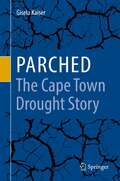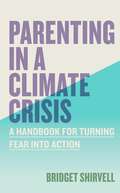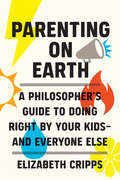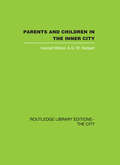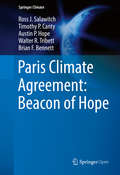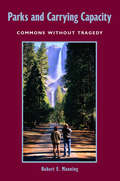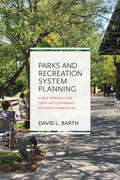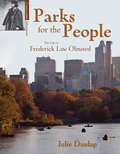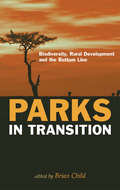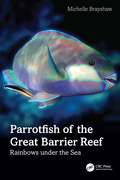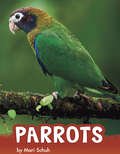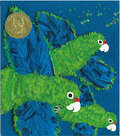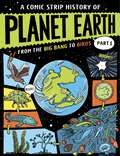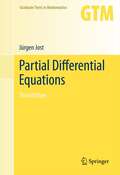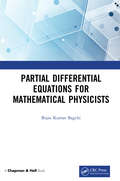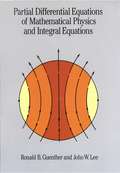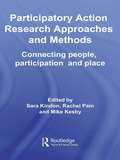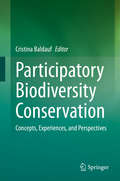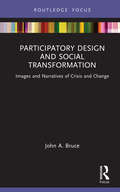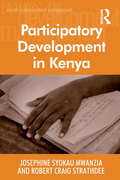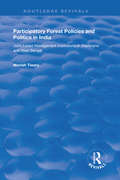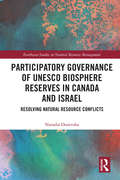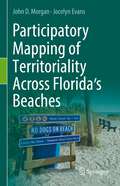- Table View
- List View
Parched - The Cape Town Drought Story
by Gisela KaiserThe book presents the history of water supply to Cape Town, leading up to the worst ever drought recorded, through political turmoil impacting on drought interventions and resulting in the adoption of an integrated water strategy.Regions reliant on water supply from rainfed dams have always been vulnerable to the impact of drought. This is exacerbated by the uncertainty of future rainfall, which is never guaranteed, and reliance is placed on modelling using historic data. While weather has always been variable, climate has been generally reliable. With anthropogenic activity causing changes in climate, the validity of modelling based on history is currently not fully trusted. Unless the storage capacity is sufficient to carry through numerous seasons of poor rainfall, even with water restrictions to match demand and supply in times of depleted rainfall, the risk of reservoirs running dry remains a threat.
Parenting in a Climate Crisis: A Handbook for Turning Fear into Action
by Bridget ShirvellIn this urgent parenting guide, learn how to navigate the uncertainty of the climate crisis and keep your kids informed, accountable, and hopeful–with simple actions you can take as a family to help the earth. Kids today are experiencing the climate crisis firsthand. Camp canceled because of wildfire smoke. Favorite beaches closed due to erosion. Recess held indoors due to extreme heat. How do parents help their children make sense of it all? And how can we keep our kids (and ourselves) from despair? Environmental journalist and parent Bridget Shirvell has created a handbook for parents to help them navigate these questions and more, weaving together expert advice from climate scientists, environmental activists, child psychologists, and parents across the country. She helps parents answer tough questions (how did we get here?) and raise kids who feel connected to and responsible for the natural world, feel motivated to make ecologically sound choices, and feel empowered to meet the challenges of the climate crisis—and to ultimately fight for change.
Parenting on Earth: A Philosopher's Guide to Doing Right by Your Kids and Everyone Else
by Elizabeth CrippsBeing parents and being human: building hope for our children in a fragile world.Environmental catastrophes, pandemics, antibiotic resistance, institutionalized injustice, and war: in a world so out of balance, what does it take—or even mean—to be a good parent? This book is one woman&’s search for an answer, as a moral philosopher, activist, and mother.Drawing on the insights of philosophy and the experience of parent activists, Elizabeth Cripps calls for parents to think radically about exactly what we owe our children—and everyone else. She shows how our children&’s needs are inseparable from the fate of the earth and the fortunes of others and how much is at stake in parenting today. And she asks the hardest question: should we have kids at all?Timely and thoughtful, Parenting on Earth extends a challenge to anyone raising children in a troubled world—and with it, a vision of hope for our children&’s future. Cripps envisions a world where kids can prosper and grow—a just world, with thriving social systems and ecosystems, where future generations can flourish and all children can lead a decent life. She explains, with bracing clarity, why those raising kids today should be a force for change and bring up their children to do the same. Hard as this can be, in the face of political gridlock, ecoanxiety, and general daily grind, the tools of philosophy and psychology can help us find a way.
Parents and Children in the Inner City
by Harriett Wilson G.W. HerbertThis book was first published in 1978.
Paris Climate Agreement: Beacon of Hope
by Ross J. Salawitch Timothy P. Canty Austin P. Hope Walter R. Tribett Brian F. BennettThis book is open access under a CC BY 4. 0 license. This volume presents an Empirical Model of Global Climate developed by the authors and uses that model to show that global warming will likely remain below 2#65533;C, relative to preindustrial, throughout this century provided: a) both the unconditional and conditional Paris INDC commitments are followed; b) the emission reductions needed to achieve the Paris INDCs are carried forward to 2060 and beyond. The first section of the book provides a short overview of Earth's climate system, describing and contrasting climatic changes throughout the planet's history and anthropogenic changes post-Industrial Revolution. The second section describes the climate model developed by the authors (Canty et al. , Atmospheric Chemistry and Physics, 2013) and contrasts the model with climate models used in the Intergovernmental Panel on Climate Change (IPCC) 2013 Report. Chapter 3 examines both the unconditional (i. e. , firm commitments) and conditional Paris INDCs (commitments contingent on financial flow and/or technology transfer) through the lens of their climate model and concludes that if all of the Paris INDCs are followed, then they are indeed a beacon of hope for Earth's climate. The fourth part of the book offers a perspective of energy needs and subsequent emissions reductions required to meet the Paris temperature goals, illuminating challenges faced both in the developing world and the developed world. Throughout the book, easy-to-understand charts and graphics illustrate concepts. The scientific basis of Chapters 2 and 3 was first presented in a keynote session of the 96th Annual Meeting of the American Meteorological Society in January, 2016.
Parisar Adyayan Bhag-1 class 4 - Maharashtra Board: परिसर अध्ययन भाग-१ ४थीं कक्षा - महाराष्ट्र बोर्ड
by Maharashtra Rajya Pathyapustak Nirmiti Va Abhysakram Sanshodhan Mandal Pune"परिसर अध्ययन (भाग 1)" महाराष्ट्र राज्य पाठ्यपुस्तक मंडल द्वारा प्रकाशित चौथी कक्षा के लिए एक महत्वपूर्ण पाठ्यपुस्तक है। यह पुस्तक विद्यार्थियों को उनके प्राकृतिक, सामाजिक, और सांस्कृतिक परिवेश को समझने में मदद करती है। इसमें प्राणियों, पौधों, जल, हवा, मानचित्र, परिवहन, संचार, प्राकृतिक आपदाएँ और सामूहिक जीवन जैसे विषयों को सरल और रोचक भाषा में प्रस्तुत किया गया है। पुस्तक का उद्देश्य बच्चों में पर्यावरणीय जागरूकता बढ़ाना, सामूहिक उत्तरदायित्व सिखाना और जीवन कौशल विकसित करना है। इसके अध्याय गतिविधियों, स्वाध्याय और रोचक चित्रों से भरे हैं, जो बच्चों की कल्पनाशक्ति और रचनात्मकता को प्रेरित करते हैं। यह पुस्तक बच्चों को पर्यावरण का सम्मान करना, संसाधनों का उपयोग सही तरीके से करना, और वैज्ञानिक दृष्टिकोण अपनाने के लिए प्रेरित करती है। यह बच्चों के व्यवहार, ज्ञान और सोचने की क्षमता को सुधारने में मददगार है।
Parisar Adyayan Bhag-1 class 5 - Maharashtra Board: परिसर अध्ययन भाग-१ ५वीं कक्षा - महाराष्ट्र बोर्ड
by Maharashtra Rajya Pathyapustak Nirmiti Va Abhysakram Sanshodhan Mandal Pune"परिसर अध्ययन भाग 1" महाराष्ट्र बोर्ड की कक्षा 5 की हिंदी पाठ्यपुस्तक है, जो प्राकृतिक, सामाजिक और सांस्कृतिक परिवेश की जानकारी प्रदान करती है। इसमें छात्रों को पृथ्वी, पर्यावरण, मानचित्र, नागरिक शास्त्र, परिवार, सार्वजनिक सुविधाएँ, जल स्रोत, खाद्य सुरक्षा, संचार, परिवहन, स्वास्थ्य और समुदाय से जुड़ी मूलभूत अवधारणाएँ सिखाई जाती हैं। पुस्तक में वैज्ञानिक दृष्टिकोण विकसित करने पर बल दिया गया है और छात्र गतिविधियों के माध्यम से व्यावहारिक ज्ञान प्राप्त कर सकते हैं। इसमें चित्र, मानचित्र, प्रश्नोत्तर, और व्यावहारिक गतिविधियाँ शामिल हैं, जो छात्रों को अपने आसपास के वातावरण को समझने और उसमें सुधार करने के लिए प्रेरित करती हैं। इस पाठ्यपुस्तक का उद्देश्य बच्चों को आत्मनिर्भर और जागरूक नागरिक बनाना है, जो समाज और पर्यावरण के प्रति उत्तरदायी हों।
Parks and Carrying Capacity: Commons Without Tragedy
by Robert E. ManningHow much can we use the environment without spoiling what we find so valuable about it? Determining the carrying capacity of parks and related areas is a perennial question whose urgency grows each year as the number of visits continues to increase. Parks and Carrying Capacity represents a comprehensive assessment of the issue, as it:* offers a historical and conceptual treatment ofcarrying capacity* describes and illustrates research approaches forassessing carrying capacity, including qualitative and quantitativesurveys, normative theory and methods, visual research approaches,trade-off analysis, and simulation modeling* examines management alternatives for limiting the environmentaland social impacts of visitor use* considers the broader question of environmental management andhow the issue of carrying capacity can be applied more generally* discusses how the theory and methods associated with managingthe carrying capacity of parks and protected areas might be extendedto other areas of environmental managementThe book includes a series of case studies that describe research programsdesigned to support analysis and management of carrying capacity at eight diverse units of the U.S. National Park System, and an additional case study that explores how the foundational components of carrying capacity (formulating indicators and standards, monitoring, and adaptive management) are being applied in an increasing number of environmental and natural resources fields to address the growing urgency of sustainability. Parks and Carrying Capacity is an important new work for faculty, graduate and undergraduate students, and researchers in outdoor recreation, park planning and management, and natural resource conservation and management, as well as for professional planners and managers involved with park and outdoor recreation related agencies and nongovernmental organizations.
Parks and Recreation System Planning: A New Approach for Creating Sustainable, Resilient Communities
by David BarthParks and recreation systems have evolved in remarkable ways over the past two decades. No longer just playgrounds and ballfields, parks and open spaces have become recognized as essential green infrastructure with the potential to contribute to community resiliency and sustainability. To capitalize on this potential, the parks and recreation system planning process must evolve as well. In Parks and Recreation System Planning, David Barth provides a new, step-by-step approach to creating parks systems that generate greater economic, social, and environmental benefits.Barth first advocates that parks and recreation systems should no longer be regarded as isolated facilities, but as elements of an integrated public realm. Each space should be designed to generate multiple community benefits. Next, he presents a new approach for parks and recreation planning that is integrated into community-wide issues. Chapters outline each step—evaluating existing systems, implementing a carefully crafted plan, and more—necessary for creating a successful, adaptable system. Throughout the book, he describes initiatives that are creating more resilient, sustainable, and engaging parks and recreation facilities, drawing from his experience consulting in more than 100 communities across the U.S.Parks and Recreation System Planning meets the critical need to provide an up-to-date, comprehensive approach for planning parks and recreation systems across the country. This is essential reading for every parks and recreation professional, design professional, and public official who wants their community to thrive.
Parks for the People
by Julie DunlapWhen Frederick Law Olmsted entered a contest to design the nation's first city park, his winning design became New York's Central Park and forever changed our nation's cities. Using historic photographs and a school resource section, award-winning children's author Julie Dunlap brings Olmsted to life in this biography of the United States' first landscape architect.Julie Dunlap is a freelance writer and researcher. Dunlap's books have been honored with a Teachers' Choice Award from Learning magazine, a Parents' Choice recommended selection, and a Junior Library Guild selection, among others.
Parks in Transition: "Biodiversity, Rural Development and the Bottom Line"
by Brian ChildParks face intense pressure from both environmental and developmental perspectives to conserve biodiversity and provide economic opportunities for rural communities. These imperatives are often in conflict, while potential solutions may be subject to theoretical and practical disagreement and complicated by pressing economic, political and cultural considerations. Parks in Transition collects the work of the most distinguished scholars and practitioners in this field, drawing on insight from over 50 case studies and synthesizing them into lessons to guide park management in transitional economies where the challenges of poverty and governance can be severe. The central message of the book is that parks are common property regimes that are supposed to serve society. It analyses and sheds light on the crucial questions arising from this perspective. If parks are set aside to serve poor people, should conservation demands over-rule demands for jobs and economic growth? Or will deliberately using parks as bridgeheads for better land use and engines for rural development produce more and better conservation? The issue that arises at all levels is that of accountability, including the problematic linkages between park authorities and political systems, and the question of how to measure park performance. This book provides vital new insights for park management, regarding the relationship between conservation and commercialization, performance management, new systems of governance and management, and linkages between parks, landscape and the land-use economy.
Parrotfish of the Great Barrier Reef: Rainbows under the Sea
by Michelle BrayshawThe array of colours found on the Scarini tribe (family: Labridae), commonly known as the Parrotfish, is truly astounding and is showcased to breathtaking effect in this book. Photographer and artist Michelle Brayshaw reveals the array of colour changes which these fish display through ontological (slow) and physiological (fast) processes. The obvious differences occur in the three phases of their lives, but it is the subtle changes in colour that can be the most bizarre, occurring while feeding, mating, courting, cleaning, camouflaging themselves to their backgrounds or the fish around them, experiencing mood swings, fighting, playing and, most excitingly of all, when they are transitioning from female to male. This feat is not unique to the Parrotfish, but no other animals do it with such glamour and colour.Through hundreds of hours of observational research, this book highlights the light play and physiological and ontological colour changes of the Scarini found on the Great Barrier Reef in stunning photographic accuracy. It also includes comprehensive information about why Parrotfish are so important for the health and resilience of the reef,f instilling in the reader a deeper sense of the treasures found there and reminding us of the interconnected nature of our existence.
Parrots (Animals)
by Mari SchuhParrots can do more than just mimic human speech. These colorful, sassy birds often mate for life, and some parrots can live 90 years or more. Learn more about these intelligent birds. <P><P><i>Advisory: Bookshare has learned that this book offers only partial accessibility. We have kept it in the collection because it is useful for some of our members. Benetech is actively working on projects to improve accessibility issues such as these.</i>
Parrots Over Puerto Rico
by Susan L. Roth Cindy TrumboreRobert F. Sibert Informational Book Award - American Library Association (ALA)A nonfiction picture book about the history of Puerto Rico and the Puerto Rican parrot, which was brought back from the brink of extinction. Also available in Spanish.Above the treetops of Puerto Rico flies a flock of parrots as green as their island home... These are Puerto Rican parrots. They lived on this island for millions of years, and then they nearly vanished from the earth forever.Puerto Rican parrots, once abundant, came perilously close to extinction in the 1960s due to centuries of foreign exploration and occupation, development, and habitat destruction. In this compelling book, Roth and Trumbore recount the efforts of the scientists of the Puerto Rican Parrot Recovery Program to save the parrots and ensure their future. Woven into the parrots' story is a brief history of Puerto Rico itself, from before the first human settlers to the present day.With striking collage illustrations, a unique format, and engaging storytelling, Parrots Over Puerto Rico invites readers to witness the amazing recovery efforts that have enabled Puerto Rican parrots to fly over their island once again.
Part 1 From the Big Bang to Birds (A Comic Strip History of Planet Earth #1)
by Anna ClaybourneA funny, fresh comic-strip look at the amazing (and very long!) history of planet EarthTake a whirlwind comic strip trip through 4.5 billion fascinating years of Earth's history, discovering how Earth and the solar system formed, how the first life evolved in the oceans, LUCA, the ancestor of all living things, what became of the dinosaurs, and much, MUCH more.Each book works as a timeline, combining information spreads with comic strip stories, and supported throughout by high-interest facts and plenty of humour. Perfect for kids aged 9 and up.Contents: Our humble home/The whole of time at a glance!/It started with a BANG!/Nothing! Or was there?/Hello sunshine!/The early Earth/Collision course/Water world/It's raining rocks!/A spark of life/Meet your ancestor! Millions of years of microbes/New cells on the block/Land on the move/Party atmosphere!/Snowball Earth/Animals arrive/Life explosion/Stepping ashore/Green scene/The age of fish/Tetrapod takeover/Day of the dinosaurs/Phew! What a scorcher!/Dinosaur battle/Sea and sky monsters/Furry and feathery/Asteroid alert!/Goodbye dinosaurs/Glossary/Index
Partial Differential Equations
by Jürgen JostThis book offers an ideal graduate-level introduction to the theory of partial differential equations. The first part of the book describes the basic mathematical problems and structures associated with elliptic, parabolic, and hyperbolic partial differential equations, and explores the connections between these fundamental types. Aspects of Brownian motion or pattern formation processes are also presented. The second part focuses on existence schemes and develops estimates for solutions of elliptic equations, such as Sobolev space theory, weak and strong solutions, Schauder estimates, and Moser iteration. In particular, the reader will learn the basic techniques underlying current research in elliptic partial differential equations. This revised and expanded third edition is enhanced with many additional examples that will help motivate the reader. New features include a reorganized and extended chapter on hyperbolic equations, as well as a new chapter on the relations between different types of partial differential equations, including first-order hyperbolic systems, Langevin and Fokker-Planck equations, viscosity solutions for elliptic PDEs, and much more. Also, the new edition contains additional material on systems of elliptic partial differential equations, and it explains in more detail how the Harnack inequality can be used for the regularity of solutions.
Partial Differential Equations for Mathematical Physicists
by Bijan Kumar BagchiPartial Differential Equations for Mathematical Physicists is intended for graduate students, researchers of theoretical physics and applied mathematics, and professionals who want to take a course in partial differential equations. This book offers the essentials of the subject with the prerequisite being only an elementary knowledge of introductory calculus, ordinary differential equations, and certain aspects of classical mechanics. We have stressed more the methodologies of partial differential equations and how they can be implemented as tools for extracting their solutions rather than dwelling on the foundational aspects. After covering some basic material, the book proceeds to focus mostly on the three main types of second order linear equations, namely those belonging to the elliptic, hyperbolic, and parabolic classes. For such equations a detailed treatment is given of the derivation of Green's functions, and of the roles of characteristics and techniques required in handling the solutions with the expected amount of rigor. In this regard we have discussed at length the method of separation variables, application of Green's function technique, and employment of Fourier and Laplace's transforms. Also collected in the appendices are some useful results from the Dirac delta function, Fourier transform, and Laplace transform meant to be used as supplementary materials to the text. A good number of problems is worked out and an equally large number of exercises has been appended at the end of each chapter keeping in mind the needs of the students. It is expected that this book will provide a systematic and unitary coverage of the basics of partial differential equations. Key Features An adequate and substantive exposition of the subject. Covers a wide range of important topics. Maintains mathematical rigor throughout. Organizes materials in a self-contained way with each chapter ending with a summary. Contains a large number of worked out problems.
Partial Differential Equations of Mathematical Physics and Integral Equations
by Ronald B. Guenther John W. LeeThis book was written to help mathematics students and those in the physical sciences learn modern mathematical techniques for setting up and analyzing problems. The mathematics used is rigorous, but not overwhelming, while the authors carefully model physical situations, emphasizing feedback among a beginning model, physical experiments, mathematical predictions, and the subsequent refinement and reevaluation of the physical model itself. Chapter 1 begins with a discussion of various physical problems and equations that play a central role in applications. The following chapters take up the theory of partial differential equations, including detailed discussions of uniqueness, existence, and continuous dependence questions, as well as techniques for constructing conclusions. Specifically, Chapters 2 through 6 deal with problems in one spatial dimension. Chapter 7 is a detailed introduction to the theory of integral equations; then Chapters 8 through 12 treat problems in more spatial variables. Each chapter begins with a discussion of problems that can be treated by elementary means, such as separation of variables or integral transforms, and which lead to explicit, analytical representations of solutions. The minimal mathematical prerequisites for a good grasp of the material in this book are a course in advanced calculus, or an advanced course in science or engineering, and a basic exposure to matrix methods. Students of mathematics, physics, engineering, and other disciplines will find here an excellent guide to mathematical problem-solving techniques with a broad range of applications. For this edition the authors have provided a new section of Solutions and Hints to selected Problems. Suggestions for further reading complete the text.
Participatory Action Research Approaches and Methods: Connecting People, Participation and Place (Routledge Studies in Human Geography)
by Rachel Pain Mike Kesby Sara KindonParticipatory Action Research (PAR) approaches and methods have seen an explosion of recent interest in the social and environmental sciences. PAR involves collaborative research, education and action which is oriented towards social change, representing a major epistemological challenge to mainstream research traditions. It has recently been the subject of heated critique and debate and rapid theoretical and methodological development. This book captures these developments, exploring the justification, theorisation, practice and implications of PAR. It offers a critical introduction to understanding and working with PAR in different social, spatial and institutional contexts. The authors engage with PAR’s radical potential, while maintaining a critical awareness of its challenges and dangers. The book is divided into three parts. The first part explores the intellectual, ethical and pragmatic contexts of PAR; the development and diversity of approaches to PAR; recent poststructuralist perspectives on PAR as a form of power; the ethic of participation; and issues of safety and well-being. Part two is a critical exploration of the politics, places and practices of PAR. Contributors draw on diverse research experiences with differently situated groups and issues including environmentally sustainable practices, family livelihoods, sexual health, gendered experiences of employment, and specific communities such as people with disabilities, migrant groups, and young people. The principles, dilemmas and strategies associated with participatory approaches and methods including diagramming, cartographies, art, theatre, photovoice, video and geographical information systems are also discussed. Part three reflects on how effective PAR is, including the analysis of its products and processes, participatory learning, representation and dissemination, institutional benefits and challenges, and working between research, action, activism and change. The authors find that a spatial perspective and an attention to scale offer helpful means of negotiating the potentials and paradoxes of PAR. This approach responds to critiques of PAR by highlighting how the spatial politics of practising participation can be mobilised to create more effective and just research processes and outcomes. The book adds significant weight to the recent critical reappraisal of PAR, suggesting why, when, where and how we might take forward PAR’s commitment to enabling collaborative social transformation. It will be particularly useful to researchers and students of Human Geography, Development Studies and Sociology.
Participatory Biodiversity Conservation: Concepts, Experiences, and Perspectives
by Cristina BaldaufIt has long been claimed that addressing biodiversity loss and other environmental problems demands a better understanding of the social dimensions of conservation; nevertheless, the active participation of indigenous peoples and local communities (IPLCs) in conservation initiatives is still a challenging and somehow controversial issue. In this context, this book hopes to give voice to other perspectives related to biodiversity conservation beyond the “fortress conservation” model and emphasize one of the pillars of democracy – popular participation. It covers a wide range of environments and issues of special significance to the topic, such as the expansion of culturally constructed niches, protected areas and food security, community-based management, participatory agroforestry, productive restoration and biocultural conservation. The contents also explore the limitations and shortcomings of participatory practices in protected areas, the relationship between the global crisis of democracy and the decline of biocultural diversity, as well as present current discussions on policy frameworks and governance systems for effective participatory biodiversity conservation. In sum, this book provides a comprehensive and realistic perspective on the social dimensions of conservation based on a series of interrelated themes in participatory biodiversity conservation. The connections between biocultural conservation and the current political and economic environment are highlighted through the chapters and the book closes with a debate on ways to reconcile human welfare, environmental justice and biodiversity conservation.
Participatory Design and Social Transformation: Images and Narratives of Crisis and Change (Routledge Focus on Environment and Sustainability)
by John A. BruceParticipatory Design and Social Transformation introduces theories and methodologies for using image-oriented narratives as modes of inquiry and proposition toward greater justice and equity for society and the environment. Participatory artistic- and design-based research encounters – being, making, and learning with people, things, and situations – are explored through practices that utilize image-oriented and cinematic narratives. Collaborative alliances are invited to consider aesthetics, visuality, attunement, reflection, reciprocity, and care as a means for transdisciplinary approaches that foster generative and ethically responsible conditions toward collective liberation. The design of spectacles is proposed as a way for collective movements to affectively contribute to positive systemic changes from the ground up. In this way, Participatory Design and Social Transformation bridges contemporary advances in design theory and practice with media and art theory, the human and social sciences, and a pedagogy of interdependence. Participatory Design and Social Transformation will be of great interest to both professional and academic communities, providing resources for researchers, artists, designers, activists, students, educators, and leaders engaged with initiatives for transformation.
Participatory Development in Kenya: Empowerment Transformation And Sustainability (Voices In Development Management Ser.)
by Josephine Syokau Mwanzia Robert Craig StrathdeeParticipatory Development (PDev) has been embraced by Third World governments and international organizations such as the World Bank as a means to reduce poverty and empower disadvantaged communities. The emphasis on creating partnerships and using participatory and people-centred approaches has obvious political appeal, yet there is evidence that in practice interventions designed to increase PDev and reduce poverty have yet to have the desired empowerment, transformation and sustainability effect. Using an in-depth study of the Basic Education Improvement Project (BEIP) implemented by the Government of Kenya, the authors of this book critically assess the fit between policy, practice and theory of PDev to shed light on theoretical debates that are on-going in development.
Participatory Forest Policies and Politics in India: Joint Forest Management Institutions in Jharkhand and West Bengal (Routledge Revivals)
by Manish TiwaryOriginally published in 2004. In a radical breakaway from colonial and postcolonial policies that were based on centralized and revenue-orientated control of forests, the government of India announced the Joint Forest Management (JFM) policy resolution in 1990. JFM promised important managerial concessions, including share in cash profit from the timber harvest to forest citizens, in exchange for management of state-owned forests. The government also asked the Forest Departments to invite village councils and NGOs to take part in the joint forest management schemes. Over a decade since its inception this volume examines the JFM, highlighting how state bureaucracy, local institutions and NGOs attempt to achieve the multiple goals of meeting subsistence needs, rural equity, sustainable forestry practices, and forest cover conservation. Investigating four institutions - village-based forest protection groups, the Forest Department, village councils, and NGOs - across the States of Jharkhand and West Bengal, the book focuses on forest citizens and how they interact with other JFM institutions. In doing so, it challenges notions of assumed virtues of moral economy and romanticized views of gender and indigenous knowledge and practices. The monograph also raises issues of social capital (local history, politics and leadership), common property resource (CPR) management and incentives for participation. While pointing out various inconsistencies that exist in the participatory forest framework, the book also shows the potential of JFM and suggests future directions forest management should take in India and elsewhere.
Participatory Governance of UNESCO Biosphere Reserves in Canada and Israel: Resolving Natural Resource Conflicts (Earthscan Studies in Natural Resource Management)
by Natasha DonevskaThis book explores how participatory governance processes help to find integrated solutions to resource-based development while protecting ecosystems in UNESCO designated areas. Participatory Governance of UNESCO Biosphere Reserves in Canada and Israel explores how stakeholders’ participation in decision-making processes related to natural resource management facilitates or hinders the obtainment of an acceptable balance between nature protection and sustainable development policies in the eyes of the participating stakeholders. A comparative analysis of nature versus development conflicts in the Megiddo and Mount Carmel biosphere reserves in Israel and the Mount Arrowsmith and Clayoquot Sound biosphere reserves in Canada, showcases the different approaches in implementing the biosphere reserve concept. The participatory processes of stakeholders, including governments, resource-based industries, local and indigenous communities and environmental NGOs established to address the local natural resource use problems are considered to be an opportunity of reconciliation among stakeholders with diverse interests, lifestyles and cultures but also improving the relationship between man and nature. Yet, achievement of these goals has proven to be a challenge. In some cases the participatory decision-making process yields benefits and in some cases it fails to deliver expected results. This book explores why is that the case. This title will be of great interest to students and scholars of natural resource management, integrated approaches to conservation and sustainable development, and participatory governance of social-ecological systems. It will also be of interest to environmental conflict mediators, participatory process facilitators, policymakers and professionals involved in managing social-ecological systems or establishing biosphere reserves.
Participatory Mapping of Territoriality Across Florida’s Beaches
by John D. Morgan Jocelyn EvansThis book offers a theoretical and practical exploration of the beach as space and places unique disciplinary lenses (Political Science and Geography). If we accept that what one possesses, one has a claim to, becoming property, then how that possession is enforced, socially, makes all the difference in defining what constitutes territoriality. Morgan and his colleagues have carried out various studies and applied various methods to study the developing coast of Florida. From these efforts, we compare the different regions of the State (e.g., Florida panhandle vs. South Florida) in terms of local beach culture and economics to unpack the topic of tension between beach property and access using firsthand accounts in many cases. This book approaches the complex topic of territoriality on Florida’s beaches from multiple perspectives but related methods involving time geography, a public space index, participatory mapping/cartography, and transboundary viewsheds. This analysis illustrates the fruitfulness of conceptualizations of property that are complex, multiplicative, and evolving. It calls for a recognition of human rights to the commons -- both now and in the future. And it highlights the constructed nature of public space - as a space that provides meaning through bodily performance and encounter. Approaches the complex topic of territoriality on Florida’s beaches from methods of participatory mapping/cartography and performance art.Offers a theoretical and practical exploration of the beach as space and place.Utilizes the lens of territoriality and field-based participant cartographic mapping to understand better how the developed shoreline is territorialized.
